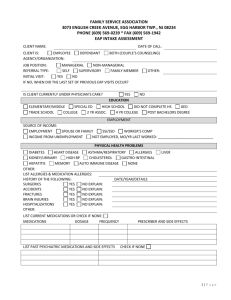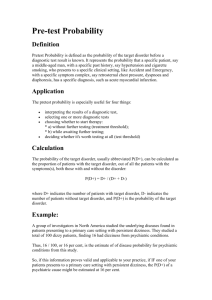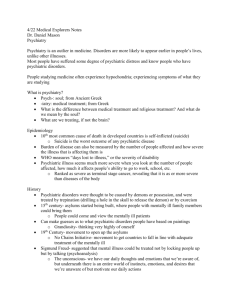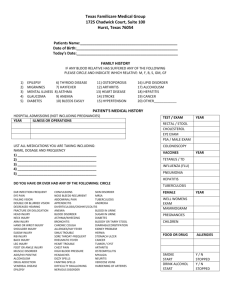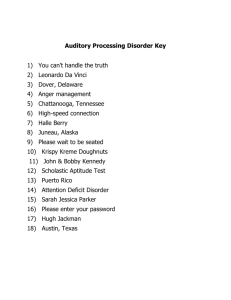LOCUS Score Sheet
advertisement
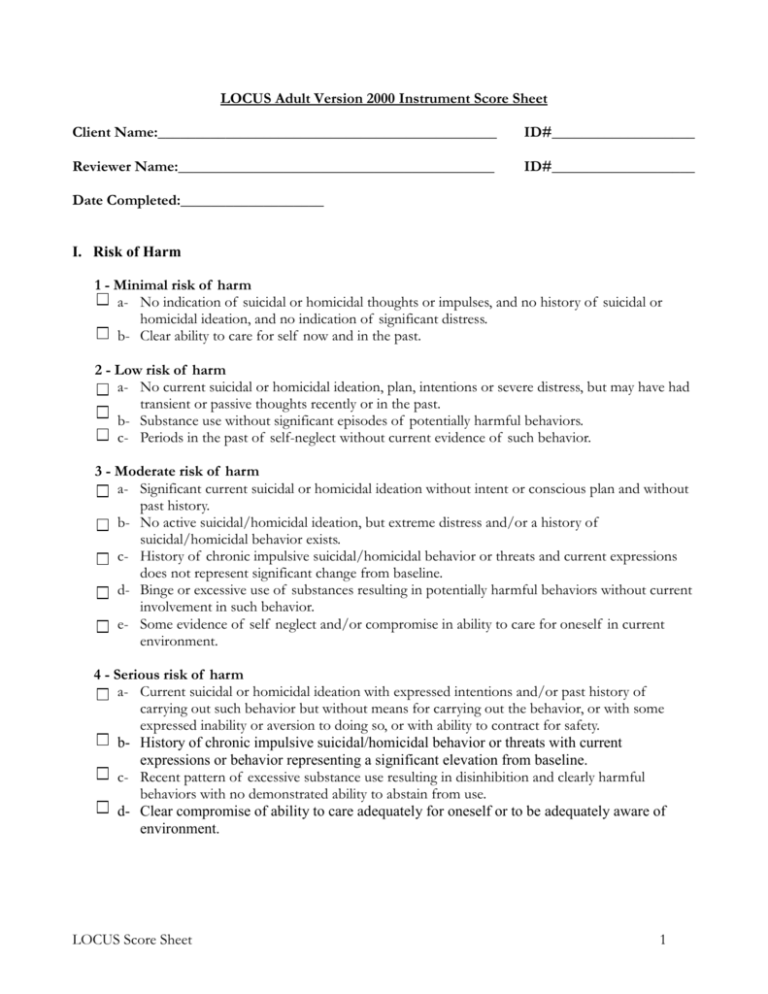
LOCUS Adult Version 2000 Instrument Score Sheet Client Name:_____________________________________________ ID#___________________ Reviewer Name:__________________________________________ ID#___________________ Date Completed:___________________ I. Risk of Harm 1 - Minimal risk of harm a- No indication of suicidal or homicidal thoughts or impulses, and no history of suicidal or homicidal ideation, and no indication of significant distress. b- Clear ability to care for self now and in the past. 2 - Low risk of harm a- No current suicidal or homicidal ideation, plan, intentions or severe distress, but may have had transient or passive thoughts recently or in the past. b- Substance use without significant episodes of potentially harmful behaviors. c- Periods in the past of self-neglect without current evidence of such behavior. 3 - Moderate risk of harm a- Significant current suicidal or homicidal ideation without intent or conscious plan and without past history. b- No active suicidal/homicidal ideation, but extreme distress and/or a history of suicidal/homicidal behavior exists. c- History of chronic impulsive suicidal/homicidal behavior or threats and current expressions does not represent significant change from baseline. d- Binge or excessive use of substances resulting in potentially harmful behaviors without current involvement in such behavior. e- Some evidence of self neglect and/or compromise in ability to care for oneself in current environment. 4 - Serious risk of harm a- Current suicidal or homicidal ideation with expressed intentions and/or past history of carrying out such behavior but without means for carrying out the behavior, or with some expressed inability or aversion to doing so, or with ability to contract for safety. b- History of chronic impulsive suicidal/homicidal behavior or threats with current expressions or behavior representing a significant elevation from baseline. c- Recent pattern of excessive substance use resulting in disinhibition and clearly harmful behaviors with no demonstrated ability to abstain from use. d- Clear compromise of ability to care adequately for oneself or to be adequately aware of environment. LOCUS Score Sheet 1 5 - Extreme risk of harm a- Current suicidal or homicidal behavior or such intentions with a plan and available means to carry out this behavior… i- without expressed ambivalence or significant barriers to doing so, or ii- with a history of serious past attempts which are not of a chronic, impulsive or consistent nature, or iii- in presence of command hallucinations or delusions which threaten to override usual impulse control. b- Repeated episodes of violence toward self or others, or other behaviors resulting in harm while under the influence of intoxicating substances with pattern of nearly continuous and uncontrolled use. c- Extreme compromise of ability to care for oneself or to adequately monitor environment with evidence of deterioration in physical condition or injury related to these deficits. II. Functional Status 1 - Minimal Impairment a- No more than transient impairment in functioning following exposure to an identifiable stressor. 2 - Mild Impairment a- Experiencing some deterioration in interpersonal interactions, with increased incidence of arguments, hostility or conflict, but is able to maintain some meaningful and satisfying relationships. b- Recent experience of some minor disruptions in aspects of self care or usual activities. c- Developing minor but consistent difficulties in social role functioning and meeting obligations such as difficulty fulfilling parental responsibilities or performing at expected level in work or school, but maintaining ability to continue in those roles. d- Demonstrating significant improvement in function following a period of deterioration. 3 - Moderate Impairment a- Becoming conflicted, withdrawn, alienated or otherwise troubled in most significant relationships, but maintains control of any impulsive or abusive behaviors. b- Appearance and hygiene may fall below usual standards on a frequent basis. c- Significant disturbances in vegetative activities such as sleep, eating habits, activity level, or sexual appetite which do not pose a serious threat to health. d- Significant deterioration in ability to fulfill responsibilities and obligations to job, school, self, or significant others and these may be avoided or neglected on some occasions. e- Chronic and/or variably severe deficits in interpersonal relationships, ability to engage in socially constructive activities, and ability to maintain responsibilities. f- Recent gains and or stabilization in function have been achieved while participating in treatment in a structured and /or protected setting. 4 - Serious Impairment a- Serious deterioration of interpersonal interactions with consistently conflictual or otherwise disrupted relations with others, which may include impulsive, or abusive behaviors. b- Significant withdrawal and avoidance of almost all social interaction. LOCUS Score Sheet 2 c- Consistent failure to maintain personal hygiene, appearance, and self care near usual standards. d- Serious disturbances in vegetative status such as weight change, disrupted sleep, or fatigue that threaten physical well being. e- Inability to perform close to usual standards in school, work, parenting, or other obligations and these responsibilities may be completely neglected on a frequent basis or for an extended period of time. 5 - Severe Impairment a- Extreme deterioration in social interactions which may include chaotic communication, threatening behaviors with little or no provocation, or minimal control of impulsive or abusive behavior. b- Development of complete withdrawal from all social interactions. c- Complete neglect of personal hygiene and appearance and inability to attend to most basic needs such as food intake and personal safety with associated impairment in physical status. d- Extreme disruptions in vegetative function causing serious harm to health and well being. e- Complete inability to maintain any aspect of personal responsibility as a citizen, or in occupational, educational, or parental roles. III. Medical, Addictive, and Psychiatric Co-Morbidity 1 - No Co-morbidity a- No evidence of medical illness, substance use disorders, or psychiatric disturbances apart from the presenting disorder. b- Any illnesses that may have occurred in the past are now stable and pose no threat to the stability of the current condition. 2 - Minor Co-morbidity a- Existence of medical problems which are not themselves immediately threatening or debilitating and which have no impact on the course of the presenting disorder. b- Occasional episodes of substance misuse, but any recent episodes are self limited, show no pattern of escalation, and there is no indication that they adversely affect the course of any coexisting psychiatric disorder. c- May occasionally experience psychiatric symptoms which are related to stress, medical illness, or substance use, but which are transient and have no discernable impact on the co-existing substance use disorder. 3 - Significant Co-morbidity a- Medical conditions exist, or have potential to develop (such as diabetes or a mild physiologic withdrawal syndrome), which may require significant medical monitoring. b- Medical conditions exist which may be adversely affected by the existence of the presenting disorder. c- Medical conditions exist which may adversely affect the course of the presenting disorder. d- Ongoing or episodic substance use occurring despite adverse consequences with significant or potentially significant negative impact on the course of any co-existing psychiatric disorder. e- Recent substance use which has had clearly detrimental effects on the presenting disorder but which has been temporarily arrested through use of a highly structured or protected setting or through other external means. LOCUS Score Sheet 3 f- Significant psychiatric symptoms and signs are present which are themselves somewhat debilitating, and which interact with and have an adverse affect on the course and severity of any co-existing substance use disorder. 4 - Major Co-morbidity a- Medical conditions exist, or have a very high likelihood of developing (such as a moderate, but uncomplicated, alcohol, sedative, or opiate withdrawal syndrome, mild pneumonia, or uncontrolled hypertension), which may require intensive, although not constant, medical monitoring. b- Medical conditions exist which are clearly exacerbated by the existence of the presenting disorder. c- Medical conditions exist which are clearly detrimental to the course and outcome of the presenting disorder. d- Uncontrolled substance use occurs at a level, which poses a serious threat to health if unabated, and/or which poses a serious barrier to recovery from any co-existing psychiatric disorder. e- Psychiatric symptoms exist which are clearly debilitating and which interact with and seriously impair ability to recover from any co-existing substance use disorder. 5 - Severe Co-morbidity a- Significant medical conditions exist which may be poorly controlled and/or potentially life threatening in the absence of close medical management (e.g., severe or complicated alcohol withdrawal, uncontrolled diabetes mellitus, complicated pregnancy, severe liver disease, debilitating cardiovascular disease). b- Presence and lack of control of presenting disorder places client in imminent danger from complications of existing medical problems. c- Uncontrolled medical condition severely exacerbates the presenting disorder, dramatically prolonging the course of illness and seriously impeding the ability to recover from it. d- Severe substance dependence with inability to control use under any circumstance with intense withdrawal symptoms and /or continuing use despite clear exacerbation of any co-existing psychiatric disorder and other aspects of well being. e- Acute or severe psychiatric symptoms are present which seriously impair client’s ability to function and prevent recovery from any co-existing substance use disorder, or seriously exacerbate it. IV. Recovery Environment A) Level of Stress 1 - Low Stress Environment a- Essentially no significant or enduring difficulties in interpersonal interactions and significant life circumstances are stable. b- No recent transitions of consequence. c- No major losses of interpersonal relationships or material status have been experienced recently. d- Material needs are met without significant cause for concern that they may diminish in the near future, and no significant threats to health or safety are apparent. LOCUS Score Sheet 4 e- Living environment poses no significant threats or risk. f- No pressure to perform beyond capacity in social role. 2 - Mildly Stressful Environment a- Presence of some ongoing or intermittent interpersonal conflict, alienation, or other difficulties. b- A transition that requires adjustment such as change in household members or a new job or school. c- Circumstances causing some distress such as a close friend leaving town, conflict in or near current habitation, or concern about maintaining material well being. d- A recent onset of a transient but temporarily disabling or debilitating illness or injury. e- Potential for exposure to alcohol and/or drug use exists. f- Performance pressure (perceived or actual) in school or employment situations creating discomfort. 3 - Moderately Stressful Environment a- Significant discord or difficulties in family or other important relationships or alienation from social interaction. b- Significant transition causing disruption in life circumstances such as job loss, legal difficulties or change of residence. c- Recent important loss or deterioration of interpersonal or material circumstances. d- Concern related to sustained decline in health status. e- Danger in or near habitat. f- Easy exposure and access to alcohol and drug use. g- Perception that pressure to perform surpasses ability to meet obligations in a timely or adequate manner. 4 - Highly Stressful Environment a- Serious disruption of family or social milieu which may be due to illness, death, divorce or separation of parent and child, severe conflict, torment and/or physical or sexual mistreatment. b- Severe disruption in life circumstances such as imminent incarceration, lack of permanent residence, or immersion in an alien culture. c- Inability to meet needs for physical and/or material well being. d- Recent onset of severely disabling or life threatening illness. e- Difficulty avoiding exposure to active users and other pressures to partake in alcohol or drug use. f- Episodes of victimization or direct threats of violence near current home. g- Overwhelming demands to meet immediate obligations are perceived. LOCUS Score Sheet 5 5 - Extremely Stressful Environment a- An acutely traumatic level of stress or enduring and highly disturbing circumstances disrupting ability to cope with even minimal demands in social spheres such as: - ongoing injurious and abusive behaviors from family member(s) or significant other. - witnessing or being victim of extremely violent incidents perpetrated by human malice or natural disaster. - persecution by a dominant social group. - sudden or unexpected death of loved one. b- Unavoidable exposure to drug use and active encouragement to participate in use. c- Incarceration or lack of adequate shelter. d- Severe pain and/or imminent threat of loss of life due to illness or injury e- Sustained inability to meet basic needs for physical and material well being; f- Chaotic and constantly threatening environment. B) Level of Support 1 - Highly Supportive Environment a- Abundant sources of support with ample time and interest to provide for both material and emotional needs in all circumstances. b- Effective involvement of Assertive Community Treatment Team (ACT) or other similarly highly supportive resources. (Selection of this criterion pre-empts higher ratings) 2 - Supportive Environment a- Supportive resources are not abundant, but are capable of and willing to provide significant aid in times of need. b- Some elements of the support system are willing and able to participate in treatment if requested to do so and have capacity to effect needed changes. c- Professional supports are available and effectively engaged (i.e. ICM). (Selection of this criterion pre-empts higher ratings) 3 - Limited Support in Environment a- A few supportive resources exist in current environment and may be capable of providing some help if needed. b- Usual sources of support may be somewhat ambivalent, alienated, difficult to access, or have a limited amount of resources they are willing or able to offer when needed. c- Persons who have potential to provide support have incomplete ability to participate in treatment and make necessary changes. d- Resources may be only partially utilized even when available. e- Limited constructive engagement with any professional sources of support which are available. 4 - Minimal Support in Environment a- Very few actual or potential sources of support are available. b- Usual supportive resources display little motivation or willingness to offer assistance or they are dysfunctional or hostile toward client. c- Existing supports are unable to provide sufficient resources to meet material or emotional needs. LOCUS Score Sheet 6 d- Client may be alienated and unwilling to use supports available in a constructive manner. 5 - No Support in Environment a- No sources for assistance are available in environment either emotionally or materially. V. Treatment and Recovery History 1 - Fully Responsive to Treatment and Recovery Management a- There has been no prior experience with treatment or recovery. b- Prior experience indicates that efforts in all treatments that have been attempted have been helpful in controlling the presenting problem. c- There has been successful management of extended recovery with few and limited periods of relapse even in unstructured environments or without frequent treatment. 2 - Significant Response to Treatment and Recovery Management a- Previous or current experience in treatment has been successful in controlling most symptoms but intensive or repeated exposures may have been required. b- Recovery has been managed for moderate periods of time with limited support or structure. 3 - Moderate or Equivocal Response to Treatment and Recovery Management a- Previous or current treatment has not achieved complete remission of symptoms or optimal control of symptoms. b- Previous treatment exposures have been marked by minimal effort or motivation and no significant success or recovery period was achieved. c- Equivocal response to treatment and ability to maintain a significant recovery. d- At least partial recovery has been maintained for moderate periods of time, but only with strong professional or peer support or in structured settings. 4 - Poor Response to Treatment and Recovery Management a- Previous or current treatment has not achieved complete remission of symptoms or optimal control of symptoms even with intensive and/or repeated exposure. b- Attempts to maintain whatever gains that can be attained in intensive treatment have limited success, even for limited time periods or in structured settings. 5 - Negligible Response to Treatment a- Past or current response to treatment has been quite minimal, even with intensive medically managed exposure in highly structured settings for extended periods of time. b- Symptoms are persistent and functional ability shows no significant improvement despite this treatment exposure. VI. Engagement 1 - Optimal Engagement a- Complete understanding and acceptance of illness and its affect on function. b- Shows strong desire to change. c- Is enthusiastic about treatment, is trusting, and shows strong ability to utilize available resources. LOCUS Score Sheet 7 d- Understands recovery process and personal role in a successful recovery plan. 2 - Positive Engagement a- Significant understanding and acceptance of illness and attempts to understand its affect on function. b- Willingness to change. c- Engages in treatment in a positive manner, capable of developing trusting relationships, and will use available resources independently when necessary. d- Shows some recognition of personal role in recovery and accepts some responsibility for it. 3 - Limited Engagement a- Some variability or equivocation in acceptance or understanding of illness and disability. b- Has limited desire or commitment to change. c- Relates to treatment with some difficulty and establishes few, if any, trusting relationships. d- Does not use available resources independently or only in cases of extreme need. e- Has limited ability to accept responsibility for recovery. 4 - Minimal Engagement a- Rarely, if ever, able to accept reality of illness or any disability which accompanies it. b- Has no desire to adjust behavior. c- Relates poorly to treatment and treatment providers and ability to trust is extremely narrow. d- Avoids contact with and use of treatment resources if left to own devices. e- Does not accept any responsibility for recovery. 5 - Unengaged a- No awareness or understanding of illness and disability. b- Inability to understand recovery concept or contributions of personal behavior to disease process. c- Unable to actively engage in treatment and has no current capacity to relate to another or develop trust. d- Extremely avoidant, frightened, or guarded. Scores Dimension I Dimension II Dimension III Dimension IVA Dimension IVB Dimension V Dimension VI Composite ________ ________ ________ ________ ________ ________ ________ ________ Placement Grid Level of Care (LOC) ________ Clinician Recommended LOC ________ Clinical Justification if Placement Grid LOC is different than Clinician Recommended LOC: LOCUS Score Sheet 8
